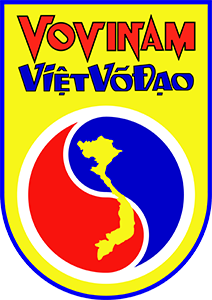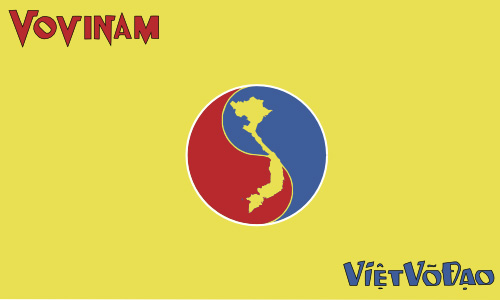PURPOSES/GOALS
Vovinam Viet Vo Dao carried out its roles with the following purposes:
- Preserve and develop the martial arts of Vietnam, applying the “Hard-Soft Co development”.
- Research and innovate new martial arts’ techniques to improve Vovinam Viet Vo Dao’s technical resources.
- Train disciples on the Strength, Techniques and Philosophy.
- + Strength: Vovinam Viet Vo Dao will train disciples to have a solid body and strong endurance against obstacles and diseases.
- + Techniques: Vovinam Viet Vo Dao will train disciples to have practical techniques for self-defense and just causes.
- + Philosophy: Vovinam Viet Vo Dao will train disciples to have a rational mind, an invincible will, and a gallant character.
Disciples will be living in a self-disciplined and forgiving way and become model citizens and serve oneself, one’s family, one’s state and mankind.
BELIEFS
To achieve the above purposes, Vovinam Viet Vo Dao follow five beliefs:
- All the functions of Vovinam Viet Vo Dao are based on an established foundation: take Mankind as the end, take Characters as the goals and take Invincible Will as the means.
- Vovinam Viet Vo Dao is an extended family, in which disciples love and respect one another. The respect and love will be the discipline of Vovinam Viet Vo Dao, which will help the disciples to unite and honor the uprightness of Vovinam Viet Vo Dao, serving mankind.
- Vovinam Viet Vo Dao actively participates in the education of young men and women.
- Vovinam Viet Vo Dao is independent of political and religious influence.
- Vovinam Viet Vo Dao always respect other disciplines of martial arts.
OBJECTIVES
There are three essential objectives:
- Live: With all the fiery and full capacity of minde and body, one must always try to improve or to perfect one’s self on three inseparate aspects – healthy body, sharp intellect and honorable spirit – thus enable the individual to be beneficial to his/her family and society.
- Help others to live: One does not use his/her advantages to bully or to rob others of their livelihoods or their rights to life, justice and the pursuit of happiness. One must respect, assist, share or create opportunities for others to achieve and to advance to the same level of comfort and happiness whenever possible.
- Live for others: This is also the highest objective; it asks the disciple to give up certain spiritual and physical benefits – even risking his/her life – for others if deemed necessary; because our lives are connected with the lives of others, our successes and achievements are often due to others’ assistance and supports…therefore, at times, we must give up ourselves to help others in the time of needs.
GENERAL MEANING OF THE CUONG-NHU CO-DEVELOPMENT THEORY
The most common explanation is that Cuong means hard and Nhu means soft. In martial arts teachings, the styles that favour Cuong often have strong and tough discipline, using external strength as its base, often very stern and direct in its dealing in life. The styles that favour Nhu often have yielding and adapt quickly to changes. In the observation of the bamboo of Vietnam, the hard, soft, durable and sharp elements equally interconnected to become one form. The bamboo is then said to be the truest essence of the Vietnamese people. Through that observation, after thorough research from many martial arts disciplines throughout the world and within national boundary, Late Founding Master Nguyen Loc utilised the principle of “Hard Soft Co-development” as the basic foundation and essence of Vovinam Viet Vo Dao. Hard-Soft Co-development is not simply a mix of both characteristics but an ever changing and adaptation in endless shapes and forms depending the environment and situation.
THE MEANING OF VOVINAM’S SALUTE
A salute is a way in which friendly people greet one another using a gesture. Each society has its own unique way of doing this. In the martial arts community, there are many ways for martial artists of various styles to greet and/or pay respect to each other and their instructors.
Vovinam’s salute : the right hand symbolises an individual’s strength or power and his/her ability to utilise that strength and power. By yielding such strength or power to the heart, the student recognises and reminds him/herself that he/she must always apply strength and power with loving intention, with humility and kindness. It is vitally important for Vovinam’s disciples of all ranks to always remember and apply the essence of
the Vovinam’s salute in his/her everyday life activity. By doing so, he/she will gain and develop friendships and respects from others, thus creating crucial and positive environment that fosters teamwork and success.
HOW TO TIE THE BELT
- Place ¼ of the belt (Viet Vo Dao side) on the rightside of the waist;
- Wrap the rest of the belt around the waist twice (or once if the belt is too short or three times if the belt is too long);
- Adjust the belt so that the two ends align with each other by shifting the entire belt to the left or right;
- Loop the one end that is on top over and under all the layers;
- Adjust the two ends once more;
- Place the upper end over the left of the under end, creating a loop and pull the upper end of the belt through this loop;
- Pull hand both ends of the belt simultaneously.
The Vovinam’s end of the belt will be on the left of the student and the Viet Vo Dao’s end will be on the right of the student. However, to the opposite viewer, Vovinam will be on the right and Viet Vo Dao on the left – exact order of historical development of these two terms.
Constant practice will ensure that the two ends of the belt will always be equal in length; thus, the student demonstrates a high degree of self-respect, pride in the uniform and pride in the martial arts discipline.
10 PRINCIPLES
As a Vovinam Viet Vo Dao Disciple, I shall:
- Strive to reach the height of martial arts in order to serve mankind.
- Faithfully build up my martial arts discipline and develop a new generation of Vovinam youth.
- Live in harmony with others, respect my seniors and love my fellow disciples.
- Absolutely obey Vovinam’s rules and regulations, and uphold the honor of a martial artist.
- Respect other disciples of martial arts, and only use force for self-defense and defense of justice.
- Work hard for personal and ethical enrichment.
- Live an honest, modest, and noble life.
- Develop the firm will to overcome all obstacles in life.
- Develop sound judgment and stamina, and act with wisdom.
- Be self-confident, self-controlled, and benevolent; and constantly review myself to strive for improvements.
EMBLEM – FLAG
The interpretation of Emblem and Flag of Vovinam Viet Vo Dao is based on the Color and Shape.


COLOR
Vovinam Viet Vo Dao has four rank colors: blue, yellow, red and white
- Blue: Represents the color of hope, which means that the disciple begins to enter in the life of a martial artist and to perceive the philosophy of martial arts.
- Yellow: Represents the color of earth, which means that the martial arts and its philosophy have permanently become a part of the Vovinam’s disciple.
- Red: Represents the color of fire, which means that the martial arts and its philosophy develop into a torch that guides the path for the Vovinam’s disciple.
- White: Represents the color of chastity, which means that the disciple’s martial arts and its philosophy has reached the absolute level and the disciple has also become the figure of the martial arts discipline of Vovinam.
SHAPE
- Flag: width is 3/5 of length; there is a Yin-Yang circle in the middle. Between the Yin-Yang is the map of Vietnam representing the life of the two opposite elements. A white circle representing the way to harmonize the difference between the Yin and Yang to preserve the eternal life surrounds the Yin-Yang circle.
- Emblem: the above ½ is the shape of the square, the below ½ is the shape of the circle, which represent the Truth-Perfection-Beauty. In the middle of the circle are the Yin-Yang circle, the map of Vietnam, and the circle of the way in corresponding to the flag.